 In our blog What can we read into signs of easing consumer confidence? we noted the slight easing in consumer confidence that had occurred since the autumn of last year. Nonetheless, at that time, survey data from the European Commission was continuing to show consumer confidence levels still well above their long-run average. However, following the UK vote to leave the European Union consumer confidence has fallen sharply and now the headline confidence indicator has fallen below its long-term average for the first time since June 2013.
In our blog What can we read into signs of easing consumer confidence? we noted the slight easing in consumer confidence that had occurred since the autumn of last year. Nonetheless, at that time, survey data from the European Commission was continuing to show consumer confidence levels still well above their long-run average. However, following the UK vote to leave the European Union consumer confidence has fallen sharply and now the headline confidence indicator has fallen below its long-term average for the first time since June 2013.
 We take this opportunity to update our May blog to better understand the extent and nature of the decline in confidence. The importance of confidence changes is typically modelled by economists in their models of the macroeconomy as a demand-side shock. Falling consumer confidence would be expected to dampen an economy’s output levels since aggregate demand falls as households spend less. Consequently, a marked fall in confidence amounts to a negative demand-side shock.
We take this opportunity to update our May blog to better understand the extent and nature of the decline in confidence. The importance of confidence changes is typically modelled by economists in their models of the macroeconomy as a demand-side shock. Falling consumer confidence would be expected to dampen an economy’s output levels since aggregate demand falls as households spend less. Consequently, a marked fall in confidence amounts to a negative demand-side shock.
The European Commission’s confidence measure is collated from questions in a monthly survey. In the UK around 2000 individuals are surveyed. Across the current 28 member states over 41 000 people are surveyed.
In the survey individuals are asked a series of 12 questions which are designed to provide information on spending and saving intentions. These questions include perceptions of financial well-being, the general economic situation, consumer prices, unemployment, saving and the undertaking of major purchases.
 The responses elicit either negative or positive responses. For example, respondents may feel that over the next 12 months the financial situation of their household will improve a little or a lot, stay the same or deteriorate a little or a lot. A weighted balance of positive over negative replies can be calculated. The balance can vary from –100, when all respondents choose the most negative option, to +100, when all respondents choose the most positive option.
The responses elicit either negative or positive responses. For example, respondents may feel that over the next 12 months the financial situation of their household will improve a little or a lot, stay the same or deteriorate a little or a lot. A weighted balance of positive over negative replies can be calculated. The balance can vary from –100, when all respondents choose the most negative option, to +100, when all respondents choose the most positive option.
The European Commission’s principal consumer confidence indicator is the average of the balances of four of the twelve questions posed: the financial situation of households, the general economic situation, unemployment expectations (with inverted sign) and savings, all over the next 12 months. These forward-looking balances are seasonally adjusted.
Sometimes other combinations of the 12 questions are averaged to produce alternative headline confidence numbers (see, for example, the newspaper articles below). These may include a mix of forward and backward-looking questions. However, in this blog we report on the European Commission’s principal confidence indicator as outlined above. The intention is that this or any other confidence indicator tracks developments in households’ spending intentions and, in turn, likely changes in the rate of growth of household consumption.
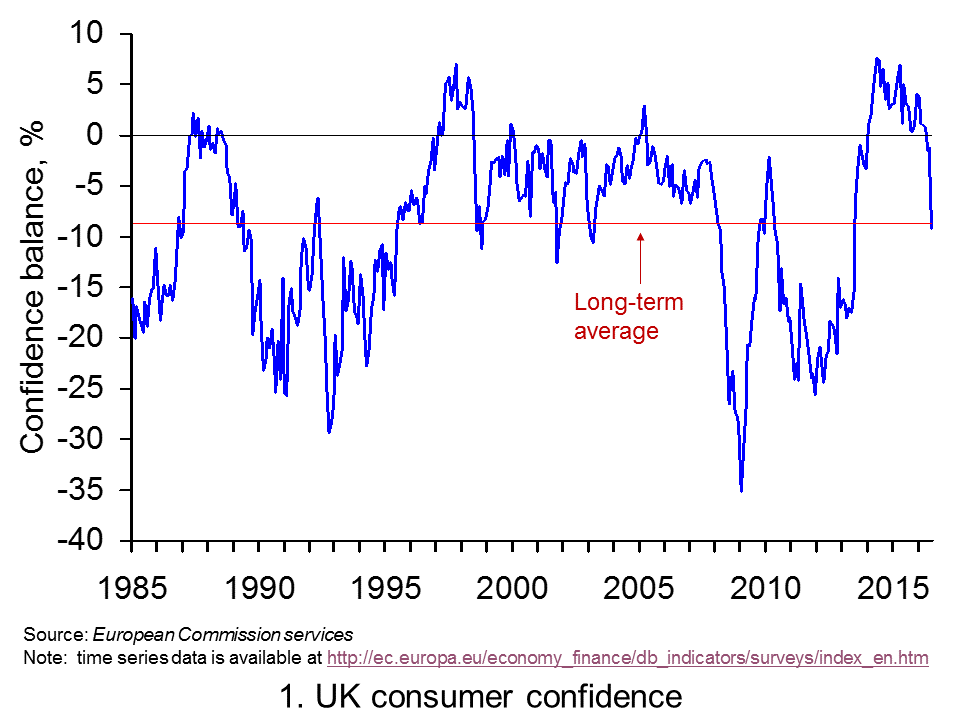 Chart 1 shows the consumer confidence indicator for the UK. The long-term average of –8.7 shows that negative responses across the four questions typically outweigh positive responses.
Chart 1 shows the consumer confidence indicator for the UK. The long-term average of –8.7 shows that negative responses across the four questions typically outweigh positive responses.
In July the confidence balance stood at –9.2 down from –1.2 in June. This 8 point fall is the largest monthly fall in this particular headline indicator since January 1991 when it fell 11 points. The fall also means that not only do negative responses now dominate but more so than is usual. The fall in confidence is therefore very stark indeed. (Click here to download a PowerPoint of the chart.)
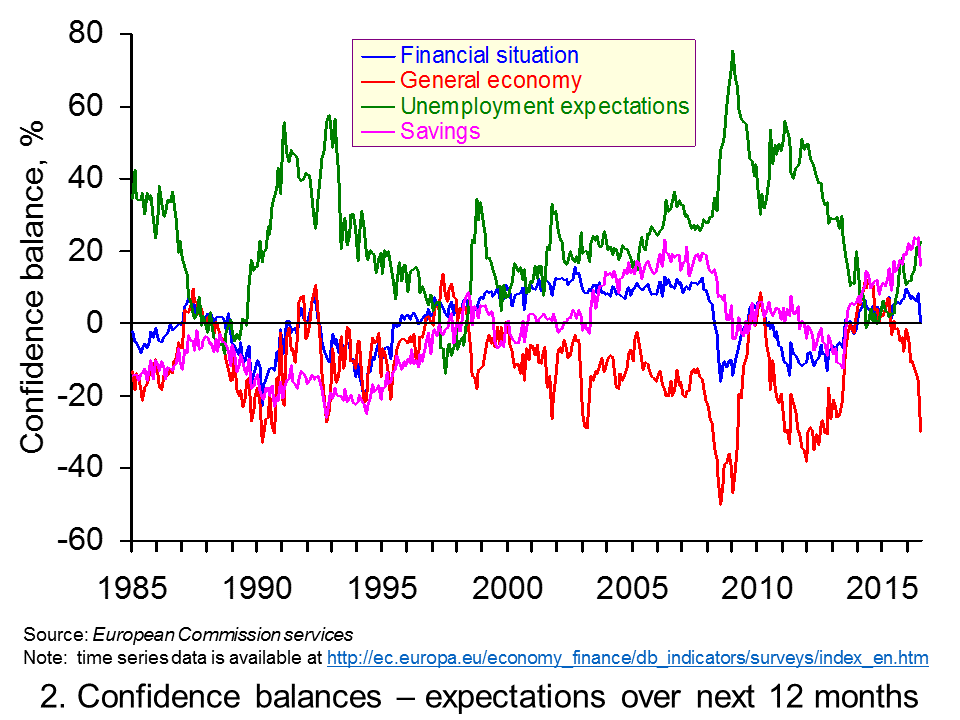 Chart 2 is important because it enables us to see what drives the European Commission’s headline confidence indicator for the UK by looking at its four component balances. The sharp decline in confidence is reflected in a deterioration in all four components. (Click here to download a PowerPoint of the chart.)
Chart 2 is important because it enables us to see what drives the European Commission’s headline confidence indicator for the UK by looking at its four component balances. The sharp decline in confidence is reflected in a deterioration in all four components. (Click here to download a PowerPoint of the chart.)
The most notable change in the individual confidence balances is the sharp deterioration in expectations for the general economy. In July the forward-looking general economic situation balance fell to –29.9 having stood at –15.7 in June. As recently as last December it registered –1.4. This is the lowest forward-looking general economy confidence balance since October 2012, though still some way above the –50.1 reported in July 2008 when the financial crisis was unfolding.
Alongside the 14 point drop in the balance for general economy expectations, the UK experienced 8 point drops in both the balances for households’ financial expectations and the expectations of saving over the next 12 months. In other words, households expect to become financially poorer and less able to save.
The monthly survey contains other questions that can help to predict future spending patterns. For example, we might expect the responses to questions relating to perceptions around what the survey call ‘major purchases’ to give us some important insight in households’ financial well-being and spending plans. ‘Major purchases’ are taken to be items such as furniture, electrical goods and electronic devices.
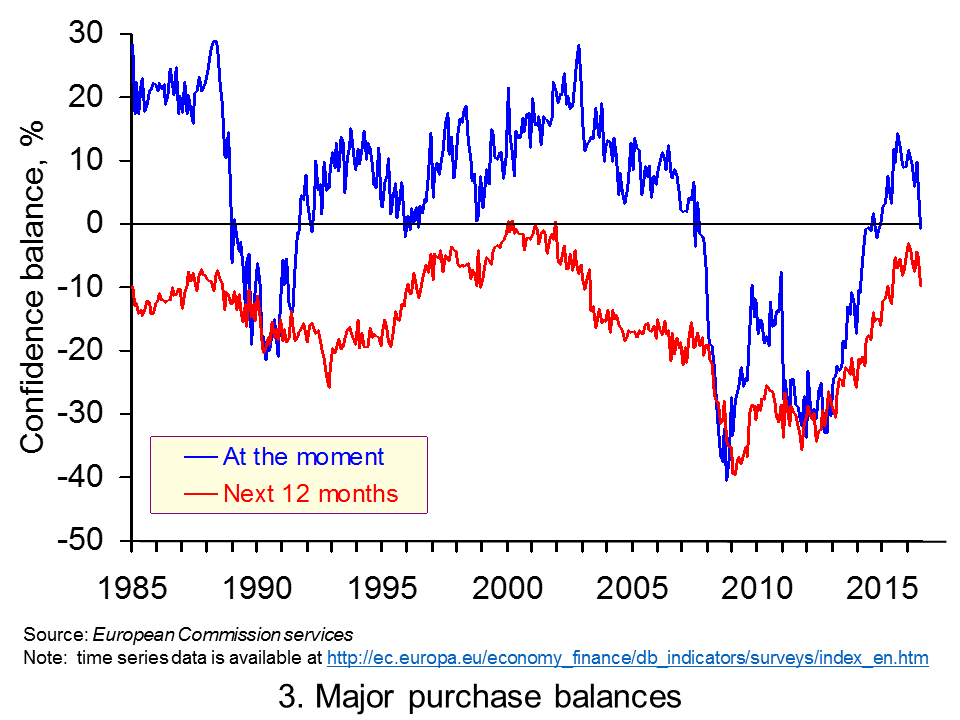 Chart 3 shows the balances to both whether now is the right time to make major purchases and to whether respondents expect to spend more on major purchases in the coming 12 months compared to the past 12 months. July’s data show a marked deterioration in sentiment towards making major purchases. The balance relating to whether now is the right time to make major purchases fell by 6.5 points, the largest fall since December 2011, while the forward-looking major purchase balance fell by 4.6 points, the largest fall since January 2011. (Click here to download a PowerPoint of the chart.)
Chart 3 shows the balances to both whether now is the right time to make major purchases and to whether respondents expect to spend more on major purchases in the coming 12 months compared to the past 12 months. July’s data show a marked deterioration in sentiment towards making major purchases. The balance relating to whether now is the right time to make major purchases fell by 6.5 points, the largest fall since December 2011, while the forward-looking major purchase balance fell by 4.6 points, the largest fall since January 2011. (Click here to download a PowerPoint of the chart.)
The fall in the major purchases balances is consistent with the idea that households are feeling a sense of heightened uncertainty. The implication of this is that households will tend to be more cautious, cutting back on expenditures, including major purchases.
The magnitude of the fall in UK consumer confidence following the outcome of the EU referendum on 23 June is even more stark when compared to developments in consumer confidence across the 28 member states of the European Union and in the 19 countries that make up the Euro area.
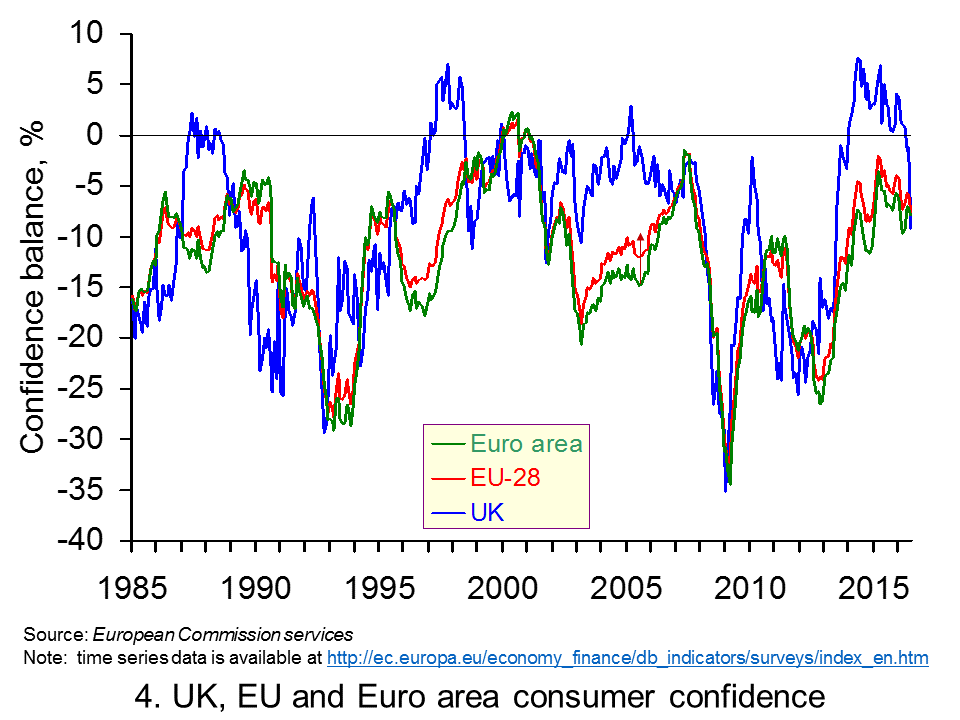 Chart 4 shows how UK consumer confidence recovered relatively more strongly following the financial crisis of the late 2000s. The headline confidence indicator rose strongly from the middle of 2013 and, as we noted earlier, was consistently in positive territory during 2014 and remained so at the start of this year. The slump in consumer confidence in the UK means that the headline confidence measure has now fallen below that across the EU as well as that in the euro area. In fact, confidence in the euro area has been consistently between –7 or –9 for the past six months. (Click here to download a PowerPoint of the chart.)
Chart 4 shows how UK consumer confidence recovered relatively more strongly following the financial crisis of the late 2000s. The headline confidence indicator rose strongly from the middle of 2013 and, as we noted earlier, was consistently in positive territory during 2014 and remained so at the start of this year. The slump in consumer confidence in the UK means that the headline confidence measure has now fallen below that across the EU as well as that in the euro area. In fact, confidence in the euro area has been consistently between –7 or –9 for the past six months. (Click here to download a PowerPoint of the chart.)
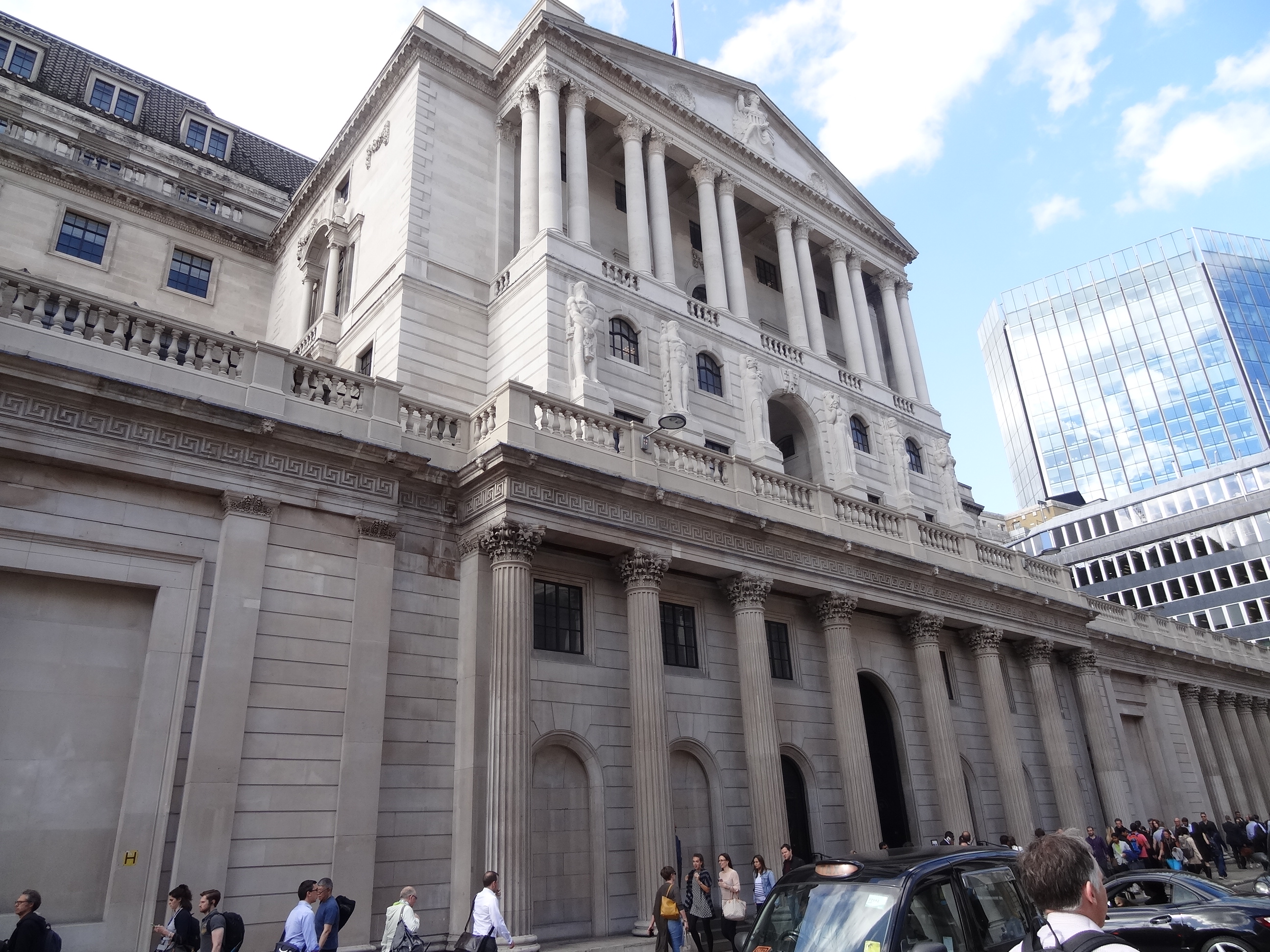 Interest now turns to whether the slump in confidence in the UK will persist or, worse still, deepen further. The implied negative impact on aggregate demand would be expected to translate into weaker growth. The concern therefore is the extent to which we can expect UK growth to weaken in the months ahead. The prospect of weaker growth is likely to influence economic policy.
Interest now turns to whether the slump in confidence in the UK will persist or, worse still, deepen further. The implied negative impact on aggregate demand would be expected to translate into weaker growth. The concern therefore is the extent to which we can expect UK growth to weaken in the months ahead. The prospect of weaker growth is likely to influence economic policy.
The government has already talked about ‘resetting fiscal policy’ which can be taken to mean a relative loosening in its fiscal policy relative to the Government’s original plans. Similarly we might yet see a further loosening of monetary policy. While the Bank of England’s Monetary Policy Committee held the official Bank Rate at 0.5 per cent at its July meeting, many commentators expect a cut sooner rather than later. The confidence data will be one important consideration in the Bank’s calculations.
Articles
UK sees biggest fall in consumer confidence for 26 years after Brexit vote The Guardian, Katie Allen (29/7/16)
UK consumer confidence takes biggest drop since 1990s ITV News (29/7/16)
Consumer confidence suffers biggest drop in 26 years after Brexit vote The Telegraph, Szu Ping Chan (29/7/16)
Consumer confidence slides at fastest pace in 26 years after Brexit vote Indepedent, Ben Chu (29/7/16)
Housing Outlook ’Uncertain’ as Brexit Hits Consumer Confidence Bloomberg, Charlotte Ryan (28/7/16)
Brexit Sees U.K. Consumer Confidence Fall Most Since 1990 Bloomberg, Charlotte Ryan (29/7/16)
Consumer confidence nosedives in Scotland in wake of Brexit vote Herald Scotland, Helen McArdle (29/7/16)
Data
Business and Consumer Surveys European Commission
Questions
- Draw up a series of factors that you think might affect consumer confidence.
- Analyse the ways in which consumer confidence might affect economic activity.
- Explain what you understand by a positive and a negative demand-side shock. How might changes in consumer confidence initiate demand shocks?
- Which of the following statements is likely to be more accurate? (a) Consumer confidence drives economic activity. (b) Economic activity drives consumer confidence.
- What macroeconomic indicators would those compiling the consumer confidence indicator hope that the indicator would help to predict?
- Analyse the possible economic implications of the fall in consumer confidence following the EU referendum vote.
- What economic effects might any persistence in the fall in consumer confidence have?
 The Brexit vote has caused shockwaves throughout European economies. But there is a potentially larger economic and political problem facing the EU and the eurozone more specifically. And that is the state of the Italian banking system and the Italian economy.
The Brexit vote has caused shockwaves throughout European economies. But there is a potentially larger economic and political problem facing the EU and the eurozone more specifically. And that is the state of the Italian banking system and the Italian economy.
Italy is the third largest economy in the eurozone after Germany and France. Any serious economic weaknesses could have profound consequences for the rest of the eurozone and beyond.
At 135% of GDP, Italy’s public-sector debt is one the highest in the world; its banks are undercapitalised with a high proportion of bad debt; and it is still struggling to recover from the crisis of 2008–9. The Economist article elaborates:
The adult employment rate is lower than in any EU country bar Greece. The economy has been moribund for years, suffocated by over-regulation and feeble productivity. Amid stagnation and deflation, Italy’s banks are in deep trouble, burdened by some €360 billion of souring loans, the equivalent of a fifth of the country’s GDP. Collectively they have provisioned for only 45% of that amount. At best, Italy’s weak banks will throttle the country’s growth; at worst, some will go bust.
Since 2007, the economy has shrunk by 10%. And potential output has fallen too, as firms have closed. Unemployment is over 11%, with youth unemployment around 40%.
Things seem to be coming to a head. As confidence in the Italian banking system plummets, the Italian government would like to bail out the banks to try to restore confidence and encourage deposits and lending. But under new eurozone rules designed to protect taxpayers, it requires that the first line of support should be from bondholders. Such support is known as a ‘bail-in’.
 If bondholders were large institutional investors, this might not be such a problem, but a significant proportion of bank bonds in Italy are held by small investors, encouraged to do so by tax relief. Bailing in the banks by requiring bondholders to bear significant losses in the value of their bonds could undermine the savings of many Italians and cause them severe hardship, especially those who had saved for their retirement.
If bondholders were large institutional investors, this might not be such a problem, but a significant proportion of bank bonds in Italy are held by small investors, encouraged to do so by tax relief. Bailing in the banks by requiring bondholders to bear significant losses in the value of their bonds could undermine the savings of many Italians and cause them severe hardship, especially those who had saved for their retirement.
So what is the solution? Italian banks need recapitalising to restore confidence and prevent a more serious crisis. However, there is limited scope for bailing in, unless small investors can be protected. And eurozone rules provide little scope for government funding for the banks. These rules should be relaxed under extreme circumstances. At the same time, policy needs to focus on making Italian banking more efficient.
Meanwhile, the IMF is forecasting that Italian economic growth will be less than 1% this year and little better in 2017. Part of the problem, claims the IMF, is the Brexit vote. This has heightened financial market volatility and increasead the risks for Italy with its fragile banking system. But the problems of the Italian economy run deeper and will require various supply-side policies to tackle low productivity, corruption, public-sector inefficiency and a financial system not fit for purpose. What the mix of these policies should be – whether market based or interventionist – is not just a question of effectiveness, but of political viability and democratic support.
Articles
The Italian Job The Economist (9/7/16)
IMF warns Italy of two-decade-long recessionThe Guardian, Larry Elliott (11/7/16)
Italy economy: IMF says country has ‘two lost decades’ of growth BBC News (12/7/16)
What’s the problem with Italian banks? BBC News, Andrew Walker (10/7/16)
Why Italy’s banking crisis will shake the eurozone to its core The Telegraph, Tim Wallace Szu Ping Chan (16/8/16)
If You Thought Brexit Was Bad Wait Until The Italian Banks All Go Bust Forbes, Tim Worstall (17/7/16)
In the euro zone’s latest crisis, Italy is torn between saving the banks or saving its people Quartz, Cassie Werber (13/7/16)
Why Italy could be the next European country to face an economic crisis Vox, Timothy B. Lee (8/7/16)
Forget Brexit, Quitaly is Europe’s next worry The Guardian, Larry Elliott (26/7/16)
Report
Italy IMF Country Report No. 16/222 (July 2016)
Data
Economic Outlook OECD (June 2016) (select ‘By country’ from the left-hand panel and then choose ‘Italy’ from the pull-down menu and choose appropriate time series)
Questions
- Can changes in aggregate demand have supply-side consequences? Explain.
- Explain why there may be a downward spiral of asset sales by banks.
- How might the principle of bail-ins for undercapitalised Italian banks be pursued without being at the expense of the small saver?
- What lessons are there from Japan’s ‘three arrows’ for Italy? Does being in the eurozone constrain Italy’s ability to adopt any or all of these three categories of policy?
- Why may the Brexit vote have more serious consequences for Italy than many other European economies?
- Find out what reforms have already been adopted or are being pursued by the Italian government. How successful are they likely to be in increasing Italian growth and productivity?
- What external factors are currently (a) favourable, (b) unfavourable to improving Italian growth and productivity?
 Since the Brexit vote in the referendum, sterling has been falling. It is now at a 31-year low against the US dollar. From 23 June to 6 July it depreciated by 12.9% against the US dollar, 10.7% against the euro and 17.0% against the yen. The trade-weighted sterling exchange rate index depreciated by 11.6%.
Since the Brexit vote in the referendum, sterling has been falling. It is now at a 31-year low against the US dollar. From 23 June to 6 July it depreciated by 12.9% against the US dollar, 10.7% against the euro and 17.0% against the yen. The trade-weighted sterling exchange rate index depreciated by 11.6%.
Why has this happened? Partly it reflects a decline in confidence in the UK economy by investors; partly it is in response to policy measures, actual and anticipated, by the Bank of England.
As far as investors are concerned, the anticipation is that there will be net direct investment outflows from the UK. This is because some companies in the UK are considering relocating part or all of their business from the UK to elsewhere in Europe. For example, EasyJet is drawing up plans to move its headquarters to continental Europe. It is also because investors believe that foreign direct investment in the UK is likely to fall as companies prefer to invest elsewhere, such as Ireland or Germany.
 Thus although the effect of net direct investment outflows (or reductions in net inflows) will be on the long-term investment part of the financial account of the balance of payments, the immediate effect is felt on the short-term financial flows part of the account as investors anticipate such moves and the consequent fall in sterling.
Thus although the effect of net direct investment outflows (or reductions in net inflows) will be on the long-term investment part of the financial account of the balance of payments, the immediate effect is felt on the short-term financial flows part of the account as investors anticipate such moves and the consequent fall in sterling.
As far as monetary policy is concerned, the fall in sterling is in response to four things announced or signalled by Mark Carney at recent news conferences (see Monetary and fiscal policies – a U-turn or keeping the economy on track?).
First is the anticipated fall in Bank Rate at the next meeting of the Monetary Policy Committee on 13/14 July. Second is the possibility of further quantitative easing (QE). Third is an additional £250bn of liquidity that the Bank is prepared to provide through its normal open-market operations. Fourth is the easing of capital requirements on banks (reducing the countercyclical buffer from 0.5% to 0%), which would allow additional lending by banks of up to £150bn.
 Lower interest rates, additional liquidity and further QE would all increase the supply of sterling on the foreign exchange markets. The anticipation of this, plus the anticipation of lower interest rates, would decrease the demand for sterling. The effect of these supply and demand changes is a fall in the exchange rate.
Lower interest rates, additional liquidity and further QE would all increase the supply of sterling on the foreign exchange markets. The anticipation of this, plus the anticipation of lower interest rates, would decrease the demand for sterling. The effect of these supply and demand changes is a fall in the exchange rate.
But is a fall in the exchange rate a ‘good thing’? As far as consumers are concerned, the answer is no. Imports will be more expensive, as will foreign holidays. People’s pounds will buy less of things priced in foreign currency and thus people will be poorer.
As far as exporters are concerned, however, the foreign currency they earn will exchange into more pounds than before. Their sterling revenues, therefore, are likely to increase. They might also choose to reduce the foreign currency price of exports, thereby increasing the quantity sold – the amount depending on the price elasticity of demand. The increase in exports and reduction in imports will help to reduce the current account deficit and also boost aggregate demand.
Articles
Pound slumps to 31-year low following Brexit vote The Guardian, Katie Allen , Jill Treanor and Simon Goodley (24/6/16)
Sterling’s post-Brexit fall is biggest loss in a hard currency Reuters, Jamie McGeever (7/7/16)
Brexit Accelerates the British Pound’s 100 Years of Debasement Bloomberg, Simon Kennedy and Lukanyo Mnyanda (5/7/16)
Pound sterling falls below $1.31 hitting new 31-year low Independent, Hazel Sheffield (5/7/16)
Viewpoints: How low will sterling go? BBC News, Leisha Chi (6/7/16)
How low will the pound fall? Financial Times (7/7/16)
Allianz’s El-Erian says UK must urgently get its act together or dollar parity could beckon Reuters, Guy Faulconbridge (7/7/16)
What does a falling pound mean for the British economy? The Telegraph, Peter Spence (6/7/16)
Data
Spot exchange rates: Statistical Interactive Database – interest & exchange rates data Bank of England
Questions
- What determines how much the exchange rate depreciates for a given shift in the demand for sterling or the supply of sterling?
- Why might the short-term effects on exchange rates of the Brexit vote be different from the long-term effects?
- Why has the pound depreciated by different amounts against different currencies?
- What are likely to be the effects on the financial and current accounts of the balance of payments of the Bank of England’s measures?
- Find out what has happened to business confidence since the Brexit vote. What effect does the level of confidence have on the exchange rate and why?
 Before the referendum, economists overwhelmingly argued that the economic case for the UK remaining in the EU was much stronger than that for leaving. They warned of serious economic consequences, both short term and long term, of a Brexit vote. And yet, by a majority of 51.9% to 48.1% of the 72.1% of the electorate who voted, the UK voted to leave the EU.
Before the referendum, economists overwhelmingly argued that the economic case for the UK remaining in the EU was much stronger than that for leaving. They warned of serious economic consequences, both short term and long term, of a Brexit vote. And yet, by a majority of 51.9% to 48.1% of the 72.1% of the electorate who voted, the UK voted to leave the EU.
Does this mean that economists failed to communicate to the electorate? Were the arguments presented poorly or in too academic a way?
Or did people simply not believe the economists’ forecasts, being cynical about the ability of economists to forecast? During the campaign, on several occasions I heard people repeating the joke that economists had successfully predicted five out of the last two recessions!
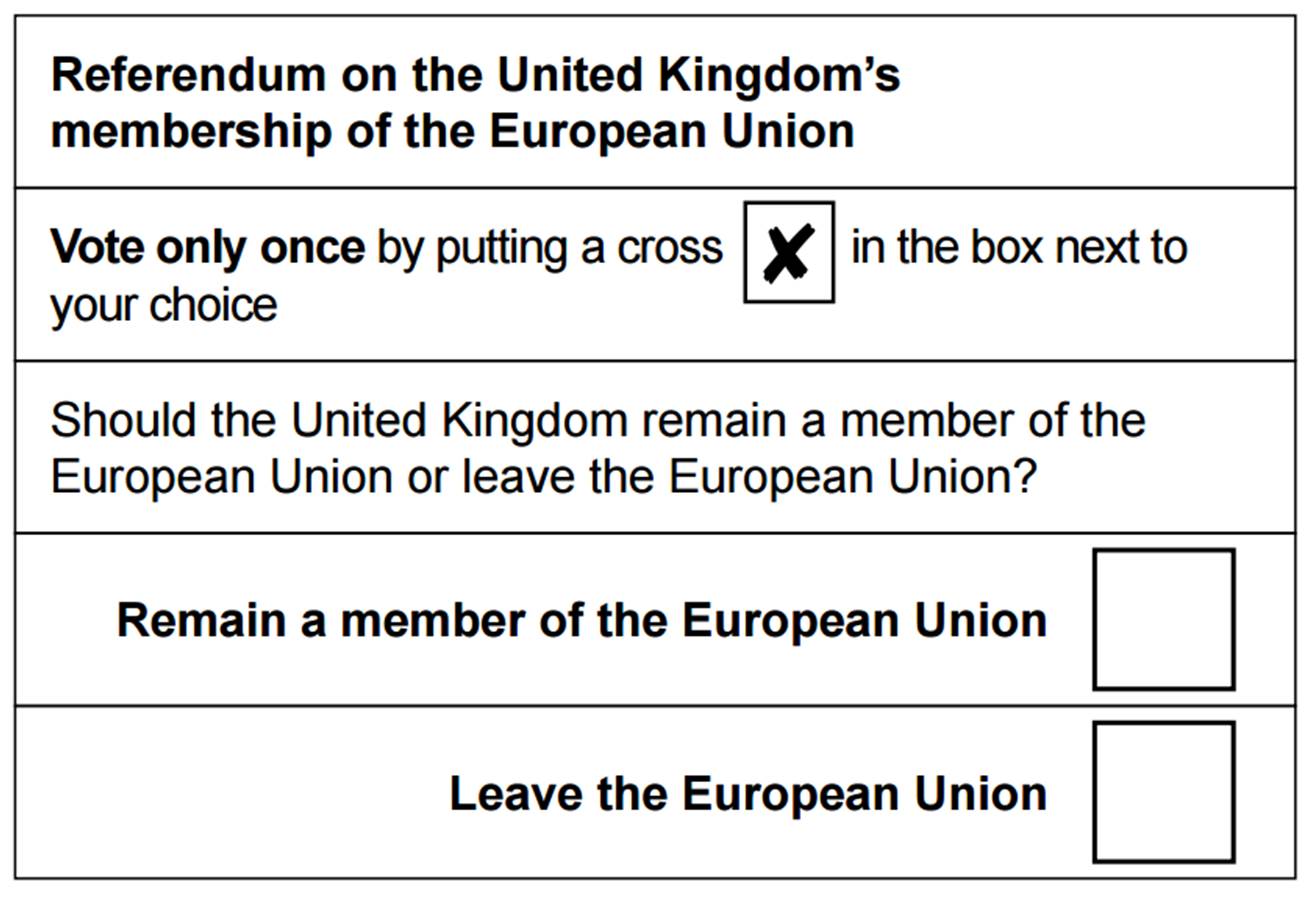 Did they not believe the data that immigrants from other EU countries to the UK contribute more in taxes they draw in benefits and that overall they make a net positive contribution to output per head? Or perhaps they believed the claims that immigrants imposed a net cost on the economy.
Did they not believe the data that immigrants from other EU countries to the UK contribute more in taxes they draw in benefits and that overall they make a net positive contribution to output per head? Or perhaps they believed the claims that immigrants imposed a net cost on the economy.
Or were there ‘non-economic’ issues that people found more persuasive, such as questions of sovereignty or national identity? Or was the strain on local resources, such as health services, schools and housing, blamed on immigration itself rather than on a lack of spending on additional resources – the funding for which could have come from the extra GDP generated by the immigration?
Or were there so many lies told by politicians and those with vested interests that people simply didn’t know whom to believe?
Economists will, no doubt, do a lot of soul searching over the coming months. One such economist is Paul Johnson, Director of the Institute for Fiscal Studies, whose article is linked below.
Article
We economists must face the plain truth that the referendum showed our failings Institute for Fiscal Studies newspaper articles. Paul Johnson (28/6/16)
Questions
- In what ways could economists have communicated better to the general public during the referendum campaign?
- For what reasons may people distrust economists?
- Were economists hampered in delivering their message by ‘balanced reporting’?
- Comment on Paul Johnson’s statement that, ‘The most politically engaged of us spend decades working out how to tweak tax policy, or labour market policy, or competition policy to deliver small benefits. How many times over would our work have been repaid if we had simply convinced a few more people of the basics?’
- Do economists, or at least some of them, need to become more ‘media savvy’?
- How could institutions, such as the Royal Economic Society and the Society of Business Economists, do more to help economists collectively to communicate with the general public?
- Give some examples of the terminology/jargon we use which might be inappropriate for communicating with the general public. Suggest some alternative terms to the examples you’ve given.
 What have been, and will be, the monetary and fiscal responses to the Brexit vote in the referendum of 23 June 2016? This question has been addressed in speeches by Mark Carney, Governor of the Bank of England, and by George Osborne, Chancellor the Exchequer. Both recognise that the vote will cause a negative shock to the economy, which will require some stimulus to aggregate demand to avoid a recession, or at least minimise its depth.
What have been, and will be, the monetary and fiscal responses to the Brexit vote in the referendum of 23 June 2016? This question has been addressed in speeches by Mark Carney, Governor of the Bank of England, and by George Osborne, Chancellor the Exchequer. Both recognise that the vote will cause a negative shock to the economy, which will require some stimulus to aggregate demand to avoid a recession, or at least minimise its depth.
Mark Carney stated that:
The Bank of England stands ready to provide more than £250bn of additional funds through its normal facilities. The Bank of England is also able to provide substantial liquidity in foreign currency, if required.
In the coming weeks, the Bank will assess economic conditions and will consider any additional policy responses.
This could mean that at its the next meeting, scheduled for 13/14 July, the Monetary Policy Committee will consider reducing Bank Rate from its current level of 0.5% and introducing further quantitative easing.
In a speech on 30 June, he went further:
I can assure you that in the coming months the Bank can be expected to take whatever action is needed to support growth subject to inflation being projected to return to the target over an appropriate horizon, and inflation expectations remaining well anchored.
Then in a speech on 5 July, introducing the latest Financial Stability Report, he said that the Bank of England’s Financial Policy Committee is lowering the required capital ratio of banks, thereby freeing up capital for lending to customers. The part being lowered is the ‘countercyclical capital buffer’ – the element that can be varied according to the state of the economy. Mark Carney said:
The FPC is today reducing the countercyclical capital buffer on banks’ UK exposures from 0.5% to 0% with immediate effect. This is a major change. It means that three quarters of UK banks, accounting for 90% of the stock of UK lending, will immediately have greater flexibility to supply credit to UK households and firms.
Specifically, the FPC’s action immediately reduces regulatory capital buffers by £5.7 billion and therefore raises banks’ capacity to lend to UK businesses and households by up to £150 billion. For comparison, last year with a fully functioning banking system and one of the fastest growing economies in the G7, total net lending in the UK was £60 billion.
Thus although there may be changes to interest rates and narrow money in response to economic reactions to the Brexit vote, the monetary policy framework remains unchanged. This is to achieve a target rate of CPI inflation of 2% at the 24-month time horizon.
 But what of fiscal policy?
But what of fiscal policy?
In its Charter for Budget Responsibility, updated in the Summer 2015 Budget, the government states its Fiscal Mandate:
3.2 In normal times, once a headline surplus has been achieved, the Treasury’s mandate for fiscal policy is:
• a target for a surplus on public-sector net borrowing in each subsequent year.
3.3 For the period outside normal times from 2015-16, the Treasury’s mandate for fiscal policy is:
• a target for a surplus on public-sector net borrowing by the end of 2019-20.
3.4 For this period until 2019-20, the Treasury’s mandate for fiscal policy is supplemented by:
• a target for public-sector net debt as a percentage of GDP to be falling in each year.
The target of a PSNB surplus by 2019-20 has been the cornerstone of recent fiscal policy. In order to stick to it, the Chancellor warned before the referendum that a slowdown in the economy as a result of a Brexit vote would force him to introduce an emergency Budget, which would involve cuts in government expenditure and increases in taxes.
 However, since the vote he is now saying that the slowdown would force him to extend the time for reaching a surplus beyond 2019-20 to avoid dampening the economy further. But does this mean he is abandoning his fiscal target and resorting to discretionary expansionary fiscal policy?
However, since the vote he is now saying that the slowdown would force him to extend the time for reaching a surplus beyond 2019-20 to avoid dampening the economy further. But does this mean he is abandoning his fiscal target and resorting to discretionary expansionary fiscal policy?
George Osborne’s answer to this question is no. He argues that extending the deadline for a surplus is consistent with paragraph 3.5 of the Charter, which reads:
3.5 These targets apply unless and until the Office for Budget Responsibility (OBR) assess, as part of their economic and fiscal forecast, that there is a significant negative shock to the UK. A significant negative shock is defined as real GDP growth of less than 1% on a rolling 4 quarter-on-4 quarter basis. If the OBR assess that a significant negative shock:
|
|
| • |
occurred in the most recent 4 quarter period; |
| • |
is occurring at the time the assessment is being made; or |
| • |
will occur during the forecast period |
then:
|
|
| • |
if the normal times surplus rule in 3.2 is in force, the target for a surplus each year is suspended (regardless of future data revisions). The Treasury must set out a plan to return to surplus. This plan must include appropriate fiscal targets, which will be assessed by the OBR. The plan, including fiscal targets, must be presented by the Chancellor of the Exchequer to Parliament at or before the first financial report after the shock. The new fiscal targets must be approved by a vote in the House of Commons. |
| • |
if the shock occurs outside normal times, the Treasury will review the appropriateness of its fiscal targets for the period until the public finances return to surplus. Any changes to the targets must be approved by a vote in the House of Commons. |
| • |
once the budget is in surplus, the target set out in 3.2 above applies. |
In other words, if the OBR forecasts that the Brexit vote will result in GDP growing by less than 1%, the Chancellor can delay reaching the surplus and thus not have to introduce tougher austerity measures. This, in effect, is what he is now saying and maintaining that, because of paragraph 3.5, it does not break the Fiscal Mandate. The nature of the next Budget, probably in the autumn, will depend on OBR forecasts.
A few days later, George Osborne announced that he plans to cut corporation tax from the current 20% to less than 15% – below the rate of 17% previously scheduled for 2019-20. His aim is not just to stimulate the economy, but to attract inward investment, as the rate would below that of any major economy and close the rate of 12.5% in Ireland. His hope would also be to halt the outflow of investment as companies seek to relocate in the EU.
Videos and podcasts
 Statement from the Governor of the Bank of England following the EU referendum result Bank of England (24/6/16)
Statement from the Governor of the Bank of England following the EU referendum result Bank of England (24/6/16)
 Uncertainty, the economy and policy – speech by Mark Carney Bank of England (30/6/16)
Uncertainty, the economy and policy – speech by Mark Carney Bank of England (30/6/16)
 Introduction to Financial Stability Report, July 2016 Bank of England (5/7/16)
Introduction to Financial Stability Report, July 2016 Bank of England (5/7/16)
 Osborne: Life will not be ‘economically rosy’ outside EU BBC News (28/6/16)
Osborne: Life will not be ‘economically rosy’ outside EU BBC News (28/6/16)
 Osborne takes ‘realistic’ view over surplus target BBC News (1/7/16)
Osborne takes ‘realistic’ view over surplus target BBC News (1/7/16)
 Why has George Osborne abandoned a key economic target? BBC News (1/7/16)
Why has George Osborne abandoned a key economic target? BBC News (1/7/16)
Articles
Mark Carney says Bank of England ready to inject £250bn into economy to keep UK afloat after EU referendum Independent, Zlata Rodionova (24/6/16)
Carney Signals Rate Cuts as Brexit Chaos Engulfs Political Class Bloomberg, Scott Hamilton (30/6/16)
Bank of England hints at UK interest rate cuts over coming months to ease Brexit woes International Business Times, Gaurav Sharma (30/6/16)
Carney prepares for ‘economic post-traumatic stress’ Financial Times, Emily Cadman (30/6/16)
Bank of England warns Brexit risks beginning to crystallise BBC News (5/7/16)
Bank of England tells banks to cut buffer to boost lending Financial Times, Caroline Binham and Chris Giles (5/7/16)
George Osborne puts corporation tax cut at heart of Brexit recovery plan Financial Times (3/7/16)
George Osborne corporation tax cut is the wrong way to start EU negotiations, former WTO boss says Independent, Hazel Sheffield (5/7/16)
George Osborne abandons 2020 UK surplus target Financial Times, Emily Cadman and Gemma Tetlow (1/7/16)
George Osborne scraps 2020 budget surplus plan The Guardian, Jill Treanor and Katie Allen (1/7/16)
Osborne abandons 2020 budget surplus target BBC News (1/7/16)
Brexit and the easing of austerity BBC News, Kamal Ahmed (1/7/16)
Osborne Follows Carney in Signaling Stimulus After Brexit Bloomberg, Simon Kennedy (1/7/16)
Questions
- Explain the measures taken by the Bank of England directly after the Brexit vote.
- What will determine whether the Bank of England engages in further quantitative easing beyond the current £385bn of asset purchases?
- How does monetary policy easing (or the expectation of it) affect the exchange rate? Explain.
- How effective is monetary policy for expanding aggregate demand? Is it more or less effective than using monetary policy to reduce aggregate demand?
- Explain what is meant by (a) capital adequacy ratios (tier 1 and tier 2); (b) countercyclical buffers. (See, for example, Economics 9th edition, page 533–7 and Figure 16.2))
- To what extent does increasing the supply of credit result in that credit being taken up by businesses and consumers?
- Distinguish between rules-based and discretionary fiscal policy. How would you describe paragraph 3.5 in the Charter for Budget Responsibility?
- Would you describe George Osborne’s proposed fiscal measures as expansionary or merely as less contractionary?
- Why is the WTO unhappy with George Osborne’s proposals about corporation tax?
- What is the Nash equilibrium of countries seeking to undercut each other’s corporation tax rates?
 In our blog What can we read into signs of easing consumer confidence? we noted the slight easing in consumer confidence that had occurred since the autumn of last year. Nonetheless, at that time, survey data from the European Commission was continuing to show consumer confidence levels still well above their long-run average. However, following the UK vote to leave the European Union consumer confidence has fallen sharply and now the headline confidence indicator has fallen below its long-term average for the first time since June 2013.
In our blog What can we read into signs of easing consumer confidence? we noted the slight easing in consumer confidence that had occurred since the autumn of last year. Nonetheless, at that time, survey data from the European Commission was continuing to show consumer confidence levels still well above their long-run average. However, following the UK vote to leave the European Union consumer confidence has fallen sharply and now the headline confidence indicator has fallen below its long-term average for the first time since June 2013. We take this opportunity to update our May blog to better understand the extent and nature of the decline in confidence. The importance of confidence changes is typically modelled by economists in their models of the macroeconomy as a demand-side shock. Falling consumer confidence would be expected to dampen an economy’s output levels since aggregate demand falls as households spend less. Consequently, a marked fall in confidence amounts to a negative demand-side shock.
We take this opportunity to update our May blog to better understand the extent and nature of the decline in confidence. The importance of confidence changes is typically modelled by economists in their models of the macroeconomy as a demand-side shock. Falling consumer confidence would be expected to dampen an economy’s output levels since aggregate demand falls as households spend less. Consequently, a marked fall in confidence amounts to a negative demand-side shock. The responses elicit either negative or positive responses. For example, respondents may feel that over the next 12 months the financial situation of their household will improve a little or a lot, stay the same or deteriorate a little or a lot. A weighted balance of positive over negative replies can be calculated. The balance can vary from –100, when all respondents choose the most negative option, to +100, when all respondents choose the most positive option.
The responses elicit either negative or positive responses. For example, respondents may feel that over the next 12 months the financial situation of their household will improve a little or a lot, stay the same or deteriorate a little or a lot. A weighted balance of positive over negative replies can be calculated. The balance can vary from –100, when all respondents choose the most negative option, to +100, when all respondents choose the most positive option. Chart 1 shows the consumer confidence indicator for the UK. The long-term average of –8.7 shows that negative responses across the four questions typically outweigh positive responses.
Chart 1 shows the consumer confidence indicator for the UK. The long-term average of –8.7 shows that negative responses across the four questions typically outweigh positive responses. Chart 2 is important because it enables us to see what drives the European Commission’s headline confidence indicator for the UK by looking at its four component balances. The sharp decline in confidence is reflected in a deterioration in all four components. (Click here to download a PowerPoint of the chart.)
Chart 2 is important because it enables us to see what drives the European Commission’s headline confidence indicator for the UK by looking at its four component balances. The sharp decline in confidence is reflected in a deterioration in all four components. (Click here to download a PowerPoint of the chart.) Chart 3 shows the balances to both whether now is the right time to make major purchases and to whether respondents expect to spend more on major purchases in the coming 12 months compared to the past 12 months. July’s data show a marked deterioration in sentiment towards making major purchases. The balance relating to whether now is the right time to make major purchases fell by 6.5 points, the largest fall since December 2011, while the forward-looking major purchase balance fell by 4.6 points, the largest fall since January 2011. (Click here to download a PowerPoint of the chart.)
Chart 3 shows the balances to both whether now is the right time to make major purchases and to whether respondents expect to spend more on major purchases in the coming 12 months compared to the past 12 months. July’s data show a marked deterioration in sentiment towards making major purchases. The balance relating to whether now is the right time to make major purchases fell by 6.5 points, the largest fall since December 2011, while the forward-looking major purchase balance fell by 4.6 points, the largest fall since January 2011. (Click here to download a PowerPoint of the chart.)  Chart 4 shows how UK consumer confidence recovered relatively more strongly following the financial crisis of the late 2000s. The headline confidence indicator rose strongly from the middle of 2013 and, as we noted earlier, was consistently in positive territory during 2014 and remained so at the start of this year. The slump in consumer confidence in the UK means that the headline confidence measure has now fallen below that across the EU as well as that in the euro area. In fact, confidence in the euro area has been consistently between –7 or –9 for the past six months. (Click here to download a PowerPoint of the chart.)
Chart 4 shows how UK consumer confidence recovered relatively more strongly following the financial crisis of the late 2000s. The headline confidence indicator rose strongly from the middle of 2013 and, as we noted earlier, was consistently in positive territory during 2014 and remained so at the start of this year. The slump in consumer confidence in the UK means that the headline confidence measure has now fallen below that across the EU as well as that in the euro area. In fact, confidence in the euro area has been consistently between –7 or –9 for the past six months. (Click here to download a PowerPoint of the chart.) Interest now turns to whether the slump in confidence in the UK will persist or, worse still, deepen further. The implied negative impact on aggregate demand would be expected to translate into weaker growth. The concern therefore is the extent to which we can expect UK growth to weaken in the months ahead. The prospect of weaker growth is likely to influence economic policy.
Interest now turns to whether the slump in confidence in the UK will persist or, worse still, deepen further. The implied negative impact on aggregate demand would be expected to translate into weaker growth. The concern therefore is the extent to which we can expect UK growth to weaken in the months ahead. The prospect of weaker growth is likely to influence economic policy.









